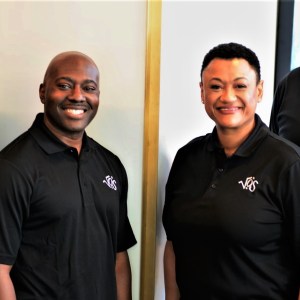The new Kansas album The Absence Of Presence officially streets today and hardcore fans are in for a musical treat. Produced by guitarist Zak Rizvi and co-produced by drummer Phil Ehart and guitarist Richard Williams, the album’s nine songs are prog rock heaven that continue the signature Kansas sound.
Keyboardist Tom Brislin, the newest member, joined the band in 2018, after stints as a hired gun for Yes, Meat Loaf, Debbie Harry and Renaissance, as well as a solo career and bandleader on his own. His playing impressed founding members Ehart and Williams, and producer Rizvi (along with vocalist Ronnie Platt, violinist David Ragsdale and bassist Billy Greer), enough that they gave him more creative control than most bands would for a newbie, including songwriting credit and a vocal spotlight.
The New Jersey native is a consummate professional, meticulous player and self-confessed gear geek who dove deep into learning every nuance of the Kansas catalog prior to getting the gig.

“I wanted to be an authority on the keyboards of Kansas and the music itself. I painstakingly transcribed every possible note I could hear on the songs we were playing, including overdubs. I wanted to have it all available and really know what was going on in the music.”
“It’s very interesting. You get into the minds of the writers and musicians when you do that. I got to see what (founding member) Kerry Livgren’s thought process was like, in terms of what chords and melodies he liked and how he orchestrated parts. And Steve Walsh too, the type of language he played on the organ and how it complemented the song. That was invaluable for getting ready to play the material but also in writing new material. I was versed enough in their language to know how to write a Kansas song.”
Brislin studied jazz in college which helped train his ear. “In jazz, a lot of it is about improvising. But in rock, people are expecting to hear those signature melodies. It’s always been part of Kansas’ identity to have great hooks. We don’t want to be self-indulgent. We want to make great songs that will stand the test of time and are meaningful. Then, in a live format at the right time is the opportunity to flesh out musically and compositionally. That’s a great freedom to have.”
Brislin gave American Songwriter a run-through of his work flow, important tools of his trade and how he built his live and studio rigs:
“First, I would just sit at the piano and play the songs and not worry about sounds. Then I built the keyboard rig to accommodate the parts. Since I’m such a gear geek, I was able to identify certain sounds.
“The orchestrated parts that make the song what it is- the synth sounds, organ, piano- I tried to really bring those to life the way I’d want to hear them. I dug into programming the original sounds and getting the classic instruments going in a modern way. I want people to turn to each other and say, ‘that’s the sound I remember!’”
“For example, one of the classic 70s string machines is the Solina. They used that in a few places and is a big part of the sound. I went into my string library and was able to tweak it accordingly to match the effect and tonal quality of the album.
“On the album, I wanted to get those analog synths because that’s something I love so much. I used Mini Moog a lot. That’s a classic part of the Kansas DNA. I used a real Hammond Organ. And of course, piano. From there, I added Clavinet, which you wouldn’t think of as much for rock but it’s in there for Kansas. When it came to textures and pads and evolving sounds, that’s where I got a little more modern. I dug into newer synthesizers and my bag of tricks.”
The only rule for me was, ‘does it sound cool?’
Tom Brislin’s studio gear:
Alesis Andromeda: I picked this synthesizer up to play on the Yes Symphonic Tour in 2001 so it has sentimental value as well as a sound I love. I find a way to work it into nearly every recording I make. It’s got an old-school flair that I found worked well as part of the sonic palette for the new Kansas album.
Roland Jupiter-6: A true 80’s classic. This was the first synth I ever played. It belongs to my brother, who was putting it to good use in the rock clubs in the 80s. It’s got a lush sound and stories to tell. I found that this also worked really well on the new Kansas material.
Hohner Clavinet E7: It’s a big part of the 70s funk sound, and I’ve always loved the sound in a rock context as well. I used it extensively on “The Song the River Sang”, the closing track from the new album.
Roswell Colares: This is a condenser microphone that I became newly acquainted with just in time for the album sessions. It’s versatile; it can sound very clean or have a more vintage saturated sound. Zak Rizvi, who mixed the album, said he liked the vocal tracks I sent him because the tones recorded from this mic responded well to his vintage EQs and compressors.
Tom Brislin’s live rig:
Hammond XK-5 Organ and Leslie 122XB rotary speaker system: I wanted to balance the authentic Kansas organ sound with the versatility of integrating the organ into my MIDI setup. It’s got a great keyboard feel, which has such a big impact on every organ part I play in the show.
Audio Modeling SWAM Solo Cello: This is a software instrument that I play via MIDI into my laptop on stage. It bears mentioning because I’m able to create realistic and expressive cello sounds, which are essential when playing the middle section of “Dust in the Wind” along with our violinist David Ragsdale.
IK Multimedia Syntronik: Another software instrument, this captures numerous killer tones from some of my favorite 70’s synths, like the Solina String Ensemble and Oberheim OB-Xa. It comes in quite handy when playing the Kansas classics!
Moog Minimoog Voyager and Sequential Prophet REV2: I made it a point to get some “real” analog sound in my live rig, and these two synths are a joy to play. Beautifully made, too.
Casio Privia PX-S3000: This is a portable and fun digital piano to play. I’ve used it in the “unplugged” portions of our show, as well as backstage to warm up and rehearse. Our front-of-house sound mixer immediately liked the way the sound fit in with the band.


Comments
Loading…